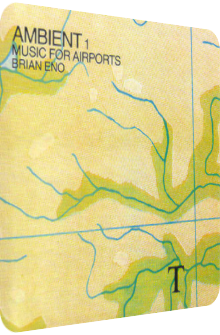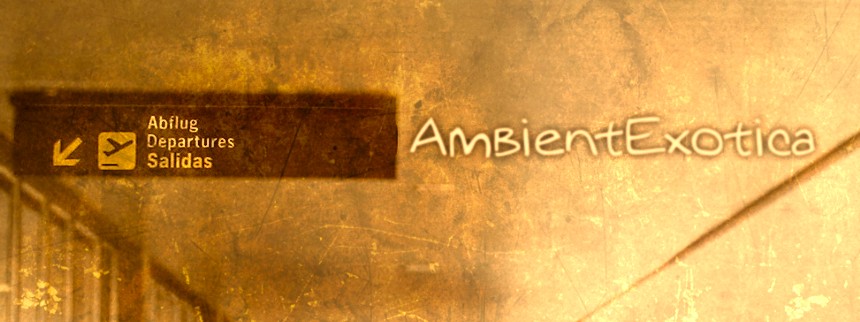
Brian Eno
Music For Airports
1978
I don't believe in the power of numbers, and yet I think that my hundredth Ambient review should be something special, whatever that means. I came up with the obvious idea of reviewing Brian Eno's world-famous and genre-establishing work Music For Airports, part one of his Ambient series that was released back in 1978. Naturally, I face many problems in this regard: is it really necessary to publish the umpteenth review of this Ambient milestone on the web? Everything has already been said about it, there is a rather short but nonetheless interesting Wikipedia entry with quotes from Eno, and there are several interviews on YouTube in which Eno further explicates the limitations of pre-Ambient music and the chances that arose from this impression. And even though I've decided to write the review anyway, further problems occur. Shall I review the music itself and deliver an intrinsic review, or is this task impossible due to the historic weight that whirls around the album? Without making this an academic debate, it is clear that, in the end, I cannot eliminate the thoughts about the importance of this work in their entirety. Keeping all these things in mind, I've decided to do the following, which, luckily, is business as usual for me: jotting down my thoughts about each of the four pieces and stating in greater detail why I like or dislike certain elements. It is only then that a second step follows which connects my ephemeral opinion with the history of the album, i.e. whether certain sounds are considered as dated nowadays, and which composition-related particularities are (hopefully) timeless and work incredibly well in our age of Pop Ambient, Glitch and Drone.
The almost 17 minutes long 1/1 begins with the – by now well-known – rising six- to nine-note piano motif and a warm analog bass drone accompaniment. Two pianos can be actually heard, one electric piano and a classic acoustic one. Co-composed with Robert Wyatt and Rhett Davies, its gently glistening synth bell eruptions that derive from the electric piano pulsate very slowly, their sustain is allowed to merge with the warm bass and the quiescence in the background. Eno works with piano loops in different speeds, so the piano sounds occasionally crunchier and at times more fragile, even majestic. Further synth strings of the silky and friendly kind merge with the established superimposition of pianos, bells and one guitar bass. During the ninth minute, the strings get even warmer, being allowed to shimmer in the long sustain-filled spaces, while in the eleventh minute, the gestalt of the backing synths morphs into a much brighter, more entrancing state. The song ends as it began, with the final breath of the piano motif and the warm bass string. The spellbinding tranquility makes this tune so utterly gorgeous, even decades after its production. Best of all: in contrast to some layers or whole songs of Eno’s presented material on Music For Airports, 1/1 doesn’t sound dated at all, thanks to its piano and carefully crafted backing synths. The main reason why many people shy away from electronic music is made obsolete by Eno. Track 2/1 sounds much more old-fashioned in comparison to the opener due to its omission of the piano. It is the modern version of a Gregorian canto, but with women and synthesizers. The angelic and dark synth swirls sound definitely sepia-colored, but the intimate and deep mood still works favorably. Although it’s almost unbelievable, the featured aaah vocals were actually sung by three women, Christine Gomez, Christa Fast and Inge Zeiniger. While the sweeps fade out and rise time and again, and while they are of the cherubic kind, there is no perceptible feeling of wideness or ethereality. The sustain of the reverberations fades off quickly. All in all, 2/1 is a dark and deep Ambient piece, but the deepness is limited due to the thinness of the synth strings. However, they coalesce incessantly, in different ways and at different points, so the song itself is skillfully conducted, but alas, the decades have weathered the synths quite a bit.
Side B brings back the acoustic piano big time in 1/2, and hence, this song sounds a little bit less dated. It is utterly melancholic and evokes a strong feeling of loneliness, but also a place for reflection. The piano theme is scattered throughout the song and is again purposefully reduced. The signature inclusion of this piece, however, consists of the reintroduction of the synth washes and the floating voices of the three women that were presented in 2/1 altogether, their melodies and performances being exactly the same. As a result, the characteristic trait of thinness remains, but on a positive note, the seraphic sound waves continue to encapsulate the listener, and I’ve read many a review on the web by people who favor exactly this peaceful heaviness and solemnity depicted in both 2/1 and 1/2. The final 2/2 is a huge favorite of mine, ending the album on a majestic note. While it sounds dated at times as well, my mind ignores this fact due to the better composition, its greater warmth and golden shimmers of coziness and conviviality. It is a synth-only piece, but it sounds tremendously real, as if a few horns and a clarinet had been used to create this sound carpet. Entangled synth pads of the warm kind flow into each other, creating a pulsating, ever-changing aural thicket, and while each of the pads is once again quite thin, their coalescence creates balmy bursts of thermal energy. There are less pauses and empty spaces in-between the fading synths than on any other track off Music For Airports, and this causes a fuller listening experience … despite the omission of belly-shaking bass drones that are so effective an inclusion in 1/1. The benign ambience is, at least to my mind, the final reason to acknowledge this early Ambient piece. It builds a great – and much needed – counterpoint to the intimate heaviness of the previous two tunes and is even more cordial than the opener. The LP version ends after six minutes, while the CD version features the original length of over nine and a half minutes. It’s a very warm tune, and Eno already uses all the tricks and gimmicks of this millennium’s Pop Ambient producers, mainly the interweaving of various layers in order to create an organic, life-like effect of seemingly arbitrary and accidental reactions between the respective ingredients. And this is the reason why I like this particular track so very much.
With Music For Airports, a theoretic concept becomes reality: providing pleasant background music that can be literally used in waiting lounges and gates at the airport for the sole purpose of letting the passengers cope with pesky contingencies such as delayed flights or crying children, but also to let them bathe in pleasant anticipation of their forthcoming trip back home or to far-away destinations. This concept, as interesting as it is, has one important flaw that is attached to the Ambient genre like a stigma to this day: if it's background music, why pay attention? Even the inventor of modern Ambient music, Brian Eno himself, stressed the background compatibility of his material. No airport visitor will listen in awe to Eno's compositions while waiting for their luggage, nervously hoping to catch the next train or nearest cab, right? As it has been written many times, Ambient music is a kind of wallpaper to slightly, carefully, almost unnoticeably enhance the atmosphere, thrill or nature of a location. However, this assertion would be soul-destroying to me after one hundred reviews and many more to follow, as it cannot be right due to the many styles, subgenres, and moods of Ambient music. Music For Airports is a milestone in regard to the modern approach of the healing, soothing nature of sound waves. The intro and the outro tracks are my favorites, while the heaviness of the album's middle section and the thinness of the synths show bold signs of increasing age that lack the technological advancements which took place during the decades. What remains besides the four compositions is a strong concept, a novelty that has never been mentioned as precisely in the title of an album as in Music For Airports. Without any field recording of starting planes, safety announcements or other hectic travel-related sounds, Eno has interwoven the kind of sumptuous majesty into each of the tracks, making them both suitable for modern architecture surroundings as well as the old-fashioned listening session at home. Best of all: you don't need to pay attention, it is only background music. If you beg to differ, maybe even strongly so, then I welcome you to AmbientExotica.com.
Further reading:
The Pitchfork review of Music For Airports is especially worth reading, as a lot of research went into the explication. It covers Eno’s concept behind the album in great detail.
Ambient Review 100: Brian Eno – Music For Airports (1978). Originally published on XYZ. XY, YEAR at AmbientExotica.com.
